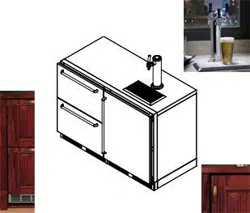Loading ...
Loading ...
Loading ...

33
Operation & Installation Manual
Signature Series Beer Dispensers (HP15, HP24 and HP48 models)
CLEANING THE BEER SYSTEM
The entire beer system, to include the faucet, exible beer
line and tapping devices must be cleaned at regular intervals.
We recommend ushing the entire system with fresh water
immediately after a keg has been emptied. Once each month
the system should be cleaned chemically.
It is recommended that you purchase Perlick’s Pump Type
Sterilizer, as shown below. It is equipped with an adapter that
attaches directly to the faucet shank in lieu of the faucet.
Part No. Description
63797 Beer line cleaning kit
BLC4 4 oz. Cleaner
BLC32 32 oz. Cleaner
Cleaning the draft beer system will help to eliminate the buildup
of the following:
Bacteria
Beer is an excellent food for bacteria (none of which is harmful).
Proper conditions may begin the growth of bacteria in the draft
beer and on the beer faucet. By regular cleaning, we prevent
this bacteria buildup and maintain the quality of the draft
beer. Greenish or yellowish colored material on the faucet may
indicate bacterial growth.
Yeast
All domestic draft beers contain a small amount of yeast which
remains in the beer from the fermentation process. When
the temperature of the draft beer exceeds 50°F, a process of
secondary fermentation may take place. The beer faucet may
exhibit a white colored substance (yeast buildup) if not cleaned
on a regular basis.
Beer Stone
All beer contains calcium which is present from the grains used
in the brewing process. It is an important natural material in
draft systems in that as it oxidizes, it’s coats the internal parts
of the beer line and equipment. This thin coat of beer stone
helps prevent the beer from picking up a strong metallic or
plastic avor as it ows through the system. The beer stone
will continue to build if the system is not cleaned properly or
regularly and can cause drawing problems if it begins to ake
o. Beer stone is present if one can see a brownish color on the
faucet or inner wall of the beer line, or tobacco-like akes in the
beer.
BEER SERVICE PROBLEMS
Wild Beer
Problem: Dispensed beer either has too much foam or is all foam.
Causes:
• Beer has been dispensed improperly-
Solution: See pouring instructions on page 33
• Regulator pressure is set too high
• Warm keg temperature-
Solution: Keg must be colder than 40°F. Target temperature is
between 36° and 38°F
• Cabinet door is opened and closed frequently and the tem-
perature is warmer than 38°F-
Solution: Adjust temperature to between 36° and 38°F.
• Kinks, dents or obstructions in the line
• Using oddly shaped glasses. Frosted, waxed or styrofoam
containers also may cause foaming.
• Dispenser has been turned o for a long period of time.
• Faucet is bad, dirty or in a worn condition.
• Regulator malfunction
Flat Beer
Problem: Foamy head disappears quickly; beer lacks brewery
fresh avor.
Causes:
• Dirty glassware
• CO2 pressure is too low due to leak or pressure setting.
• CO2 is turned o at night
• Cooler is too cold
• CO2 leak or defective (sticking) check valve
• Sluggish CO2 regulator
Cloudy Beer
Problem: Beer in glass appears hazy, not clear.
Causes:
• Dirty glassware
• Dirty faucet or beer line
• Frozen or nearly frozen beer
• Old beer
• Beer has not been refrigerated for a long period of time.
BEER AND CO2 FACTS
• Beer foam is 25% liquid beer and 75% CO2 gas. Don’t waste
it all!
• Most people prefer beer stored at 38°F.
• Beer lines and faucets require regular cleaning (see cleaning
instructions on page ###).
• A fully-charged 4.2 lb. CO2 cylinder will dispense approxi-
mately 5-1/2 or 6-1/2 barrels.
• CO2gas gives beer its sparkling eervescence. It also gives
beer its creamy head of foam.
Loading ...
Loading ...
Loading ...
